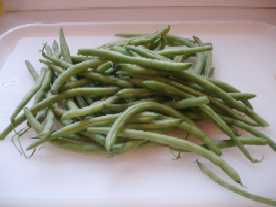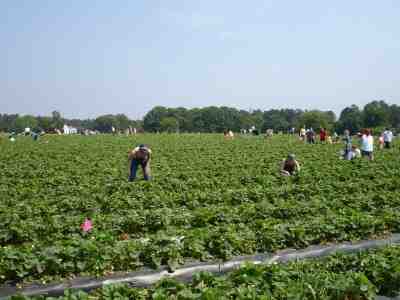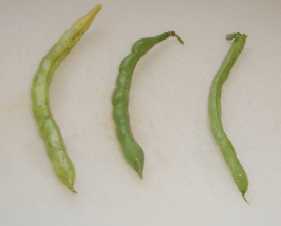
Beans - Picking Tips, Recipes, Home Canning
 Bean Picking Tips
Bean Picking Tips
Beans are so easy to grow, and yet fresh beans are absurdly expensive in most stores. And so are pickled beans! Pick your own offers a better price. This year pick or grow your own and make your own home canned food for the next pandemic winter! Whether you grow them yourself or pick them at a PYO farm, or buy them at the market, they're available fresh almost everywhere.
Here's what to look for!
When are fresh beans available?
Beans are a warm weather crop, and won't grow much in cold soil. It takes them about 60 to 70 days from seed to harvest.
In the U.S. beans typically peak in harvesting from June through October in the South, and in July to September in the North. But they can be ready as early as early June in many places, if the weather is good.
Before you leave to go to the farm:
- Always call before you go to the farm - it's hard to pick in a muddy field!
- Most growers furnish picking containers designed for beans, but they may charge you for them; be sure to call before you go to see if you need to bring containers.
- Bring something to drink and a few snacks; you'd be surprised how you can work up a thirst and appetite! And don't forget hats and sunscreen for the sun. Bugs usually aren't a problem, but some deet might be good to bring along if it has been rainy.
Tips on How to Pick Beans
Whether you pick beans from your garden or at a Pick-Your-Own farm, here are a few tips to keep in mind.
Tips on How to Pick Green Beans
- Most beans these days are "stringless". That refers to a string, tough filament of the bean that runs along the outside from one end to the other. Some beans have two, one on each side; and some have one.
- I prefer to
snap the bean off the plant just below where the stem attaches to the bean.
 If you do this, it will save time when you get home, because one end of the
bean has already been trimmed. But this only makes sense if you will be
using, cooking, canning or freezing the beans that day.
If you do this, it will save time when you get home, because one end of the
bean has already been trimmed. But this only makes sense if you will be
using, cooking, canning or freezing the beans that day. - If you won't be using the beans the same day, then break off the bean from the plant along the thin stem that connects the bean to the plant.
- The beans snap off pretty easily. hence the name "snap beans".
- Pole beans are the easiest to pick, because, since they grow up poles or twine, you don't have to squat down or bend over!
- Beans are ready for harvest when the pods are plump and firm, but not yet bulging. .
- In your own garden, pick your beans regularly to encourage more growth and prevent the pods from becoming tough and stringy.
- To harvest, hold the stem of the plant with one hand and gently snap the pod with the other..
Look for string, snap or green beans that are :
-
firm

- green (not yellowish - unless you're picking yellow beans!)
- smooth, not wrinkly on the surface - that's an old or dried out bean. Snap beans are best when the pods are firm and snap readily, but before the seeds within the pod develop. The tips should be pliable
- not lumpy - those lumps are the beans that are developed - that's an overripe green bean! Of course, if you want mature beans (not including the pod) then that's a different story, but we're talking about green beans here).
-
The beans in the photo at right are, from left:
- old and yellowing,
- overripe and lumpy; and
- dried out and damaged. - Avoid placing the picked beans in the sunlight any longer than necessary. It is better to put them in the shade of a tree or shed than in the car trunk or on the car seat. Cool them as soon as possible after picking. I prefer to bring a cooler with ice in it. Green Beans may be kept fresh in the refrigerator for 3 or 4 days
When you get home
- After harvesting, store your beans in the refrigerator or blanch and freeze them for longer storage.
- Put them in the vegetable crisper in the fridge, in a loose plastic bag.
- They will be good for about a week like that.
Bean recipes and home canning
Now, get ready to can or freeze the extra beans - It is VERY easy! Click on the links for easy instructions.
- How to can green beans, yellow beans, snap beans, broad beans, etc.
- How to make pickled beans
- How to freeze green beans (and other beans)
- How to Freeze Lima Beans, Broad beans, Butter Beans and/or Pinto Beans
- Canning fresh shelled beans
- Canned dried beans and peas (from kidney beans, peas, lima beans, broadbeans, chickpeas, pole beans, etc.)
- Canned Baked Beans With Tomato or Molasses Sauce
- Canned Baked Beans With Back, Pork or Ham and Tomato or Molasses Sauce -
- Pickled green beans
- Pickled Dill beans
- Mustard beans (pickled mustard beans)
- Pickled Three-Bean Salad
Varieties
There are many different types of beans, each with their own unique flavor, texture, and growing requirements. Some of the most popular varieties include:
- Green Beans: Also known as snap beans or string beans, green beans are a classic garden staple. They can be eaten fresh or cooked and come in bush and pole varieties.
- Lima Beans: Lima beans (called Broad Beans or Butter Beans in the UK) are a nutritious and protein-rich vegetable that can be eaten fresh or dried. They require a long growing season and prefer warm temperatures.
- Pole Beans: Pole beans are a climbing variety of bean that require support to grow. They can reach up to 10 feet tall and have a longer growing season than bush beans.
- Dried Beans: Dried beans are a versatile pantry staple that can be used in soups, stews, and other dishes. Popular varieties include black beans, navy beans, kidney beans, black beans, garbanzo (aka, chick peas) and pinto beans
Bean nutritional facts
 Green Beans
Green Beans
- One cup (125 grams) of cooked green beans contains approximately 44 calories.
- Green beans are a good source of dietary fiber, with one cup providing approximately 3.4 grams of fiber.
- They are also rich in vitamins and minerals, including vitamin C, vitamin K, vitamin A, folate, iron, and potassium.
- Green beans are low in fat, with less than 1 gram of fat per cup.
- They are a good source of plant-based protein, with one cup providing approximately 1.8 grams of protein.
- Green beans are also rich in antioxidants, such as carotenoids and flavonoids, which help protect the body against oxidative stress and inflammation.
- They are a good source of complex carbohydrates, which provide sustained energy and help regulate blood sugar levels.
Dried beans
- Dried beans are a good source of plant-based protein, with one cup (177 grams) of cooked beans providing approximately 15 grams of protein.
- They are also rich in dietary fiber, with one cup providing approximately 15 grams of fiber, or about 60% of the recommended daily value.
- Dried beans are a good source of complex carbohydrates, with one cup providing approximately 45 grams of carbohydrates, including both starch and fiber.
- They are low in fat, with less than 1 gram of fat per cup.
- Dried beans are a good source of essential vitamins and minerals, including folate, iron, magnesium, phosphorus, potassium, and zinc.
- They are also rich in antioxidants, such as flavonoids and carotenoids, which have been linked to a reduced risk of chronic diseases such as heart disease and cancer.
- Some varieties of dried beans, such as black beans, kidney beans, and pinto beans, have been shown to have a low glycemic index, meaning they have a slower impact on blood sugar levels and may help regulate blood sugar in people with diabetes.
Growing Beans
Beans are relatively easy to grow and require minimal care. They prefer a sunny spot with well-draining soil. Before planting, amend your soil with compost or well-rotted manure to provide nutrients for your plants.
Plant your seeds in the spring, after the danger of frost has passed. Make sure to space your seeds or seedlings according to the variety you're growing, following the instructions on the seed packet.
Water your plants regularly and keep an eye out for pests such as aphids or spider mites. You can use organic methods to control these pests, such as spraying with a mixture of water and dish soap or planting companion plants that repel insects.
Weird bean facts
- The scientific name for beans is legumes
- The world's largest green bean casserole weighed over 1,009 kilograms (2,225 pounds) and was created in 2017 in the United States.
- Lima beans are named after the city of Lima, Peru, where they were first cultivated over 7,000 years ago.
- The oldest known bean remains were discovered in Thailand and date back to approximately 9,000 years ago.
- In some cultures, it is considered bad luck to eat beans at night because they are thought to contain evil spirits.
- The musical fruit reputation of beans comes from the fact that they contain complex sugars that can be difficult to digest, leading to flatulence.
- Beans were a staple food for the ancient Greeks and Romans, and were often served with bread and wine.
- The Aztecs of Mexico believed that beans were the souls of their ancestors, and would often include them in religious ceremonies.
- Some types of beans, such as the fava bean, can cause a rare genetic disorder called favism in people with certain genetic mutations.
- In some countries, such as Italy and France, it is common to serve beans as a breakfast food, often mixed with eggs.
- In the United States, the third week of September is National Bean Day, and is celebrated with festivals and bean-themed events.
Looking for canning equipment and supplies?
Water bath canner with a jar rack
Pressure canners for gas, electric and induction stoves: Presto 23Qt or T-fal 22Qt
Canning scoop (this one is PERFECT)
Ball Blue book (most recent version)
Jars: 8oz canning jars for jams
Find Other types of farms:
Farm markets and roadside stands
Road trips and camping resources
Local Honey, apiaries, beekeepers
Consumer fraud and scams information
Home canning supplies at the best prices on the internet!
Maple Syrup Farms, sugarworks, maple syrup festivals
Environmental information and resources
Farms For Your Event for birthday parties, weddings, receptions, business meetings, retreats, etc.
Festivals - local fruit and vegetable festivals
Get the
most recent version of
the Ball Blue Book
With this Presto 23 quart pressure canner and pressure cooker, you can "can" everything, fruits, vegetables, jams, jellies, salsa, applesauce, pickles, even meats, soups, stews. Model 01781

You can make jams, jellies, can fruit, applesauce, salsa and pickles with water bath canners, like this Granite Ware 12-Piece Canner Kit, Jar Rack, Blancher, Colander and 5 piece Canning Tool Set

